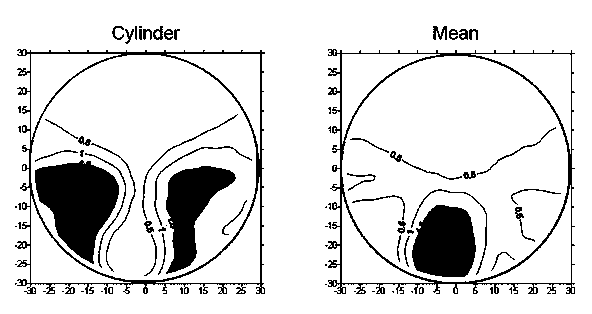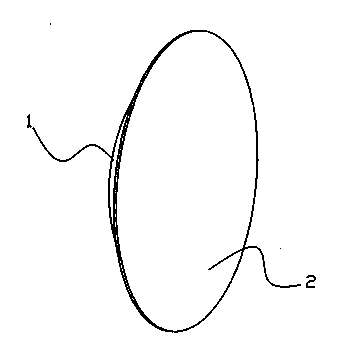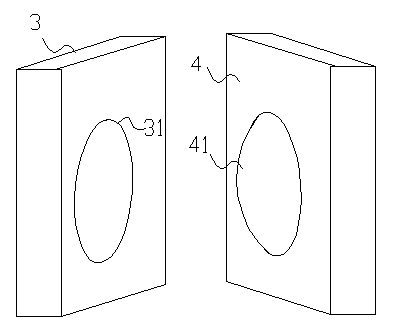Wide screen intelligent presbyopic lens and preparation mould thereof
An intelligent, wide-screen technology, applied in glasses/goggles, optics, instruments, etc., can solve problems such as visual fatigue, easy to cause discomfort, discomfort, etc., to achieve the effect of easy wearing, improved convenience and comfort
- Summary
- Abstract
- Description
- Claims
- Application Information
AI Technical Summary
Problems solved by technology
Method used
Image
Examples
Embodiment 1
[0071] ADD75 widescreen intelligent presbyopia lens free-form surface design
[0072] see figure 2 and image 3 , a wide-screen intelligent presbyopic lens, comprising a front surface 1 and a rear surface 2, both of the front surface and the rear surface are free-form surfaces, and the free-form surfaces include a far-sighted area, a near-sighted area, and a The gradient zone between the near and near zones.
[0073] The curved surface of the viewing distance zone is a polynomial surface, and the shape of the curved surface of the viewing distance zone is determined by the following function:
[0074]
[0075] In the formula, Zsy is the sagittal height at a certain point (X, Y) on the aspherical refraction surface in the far-sighted zone;
[0076] Csy is the curvature at the center of the apex of the aspheric refractive surface in the far-sighted zone, and ,
[0077] ;
[0078] Dsy is the diopter of the far zone;
[0079] n is the refractive index of the mat...
Embodiment 2
[0161] ADD100 widescreen intelligent presbyopia lens free-form surface design
[0162] see figure 2 and image 3 , a wide-screen intelligent presbyopic lens, comprising a front surface 1 and a rear surface 2, both of the front surface and the rear surface are free-form surfaces, and the free-form surfaces include a far-sighted area, a near-sighted area, and a The gradient zone between the near and near zones.
[0163] The curved surface of the viewing distance zone is a polynomial surface, and the shape of the curved surface of the viewing distance zone is determined by the following function:
[0164]
[0165] In the formula, Zsy is the sagittal height at a certain point (X, Y) on the aspherical refraction surface in the far-sighted zone;
[0166] Csy is the curvature at the center of the apex of the aspheric refractive surface in the far-sighted zone, and ,
[0167] ;
[0168] Dsy is the diopter of the far zone;
[0169] n is the refractive index of the ma...
Embodiment 3
[0248] ADD150 widescreen intelligent presbyopia lens free-form surface design
[0249] see figure 2 and image 3 , a wide-screen intelligent presbyopic lens, comprising a front surface 1 and a rear surface 2, both of the front surface and the rear surface are free-form surfaces, and the free-form surfaces include a far-sighted area, a near-sighted area, and a The gradient zone between the near and near zones.
[0250] The curved surface of the viewing distance zone is a polynomial surface, and the shape of the curved surface of the viewing distance zone is determined by the following function:
[0251]
[0252] In the formula, Zsy is the sagittal height at a certain point (X, Y) on the aspherical refraction surface in the far-sighted zone;
[0253] Csy is the curvature at the center of the apex of the aspheric refractive surface in the far-sighted zone, and ,
[0254] ;
[0255] Dsy is the diopter of the far zone;
[0256] n is the refractive index of the mat...
PUM
 Login to View More
Login to View More Abstract
Description
Claims
Application Information
 Login to View More
Login to View More - R&D
- Intellectual Property
- Life Sciences
- Materials
- Tech Scout
- Unparalleled Data Quality
- Higher Quality Content
- 60% Fewer Hallucinations
Browse by: Latest US Patents, China's latest patents, Technical Efficacy Thesaurus, Application Domain, Technology Topic, Popular Technical Reports.
© 2025 PatSnap. All rights reserved.Legal|Privacy policy|Modern Slavery Act Transparency Statement|Sitemap|About US| Contact US: help@patsnap.com



